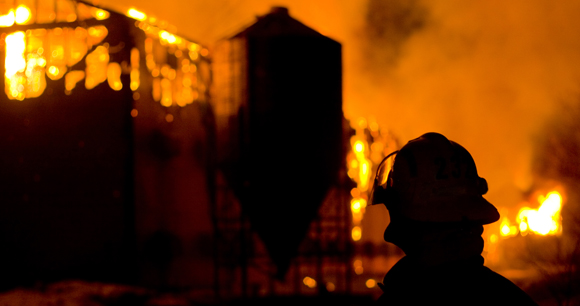This past year, over 1.6 million farm animals were reported killed in barn fires across the United States, making 2020 the deadliest year since AWI began tracking these incidents through media reports. Since 2013, more than 5 million animals have died in barn fires throughout the country, and the problem appears to be only escalating. Unfortunately, there are no state or federal laws in the United States designed to protect farm animals from barn fires.

As reported by the media, Nebraska experienced the most animal deaths in 2020 from barn fires (400,000 in three fires), followed by Michigan (300,000 in eight fires), California (280,000 in five fires), and New Jersey (280,000 in one fire). Of the 89 barn fires tracked by AWI last year, New York reported the most (10), followed by Pennsylvania (9).
As in previous years, chickens—particularly egg-laying hens—fared the worst, accounting for 90 percent of all farm animals killed by fire in 2020. Additionally, there appears to be a rise in fires at cage-free egg production facilities, which have killed nearly 1.3 million hens this past year alone. The four barn fires with the highest number of farm animal deaths, each of which took the lives of hundreds of thousands of animals at once, all involved cage-free hens at large commercial facilities.
It is no surprise that we continue to see extraordinarily high casualties at commercial egg farms, given that laying hens are confined by the largest numbers, with the least amount of space per animal. In cage-free housing in particular, scientific research has documented dust levels up to nine times higher than in cage housing. AWI is currently researching the causes of recent large fires at egg production facilities, but we suspect that high levels of dust, alone or in combination with litter, contributes to the number and severity of fires in cage-free (but still-crowded) barns.
Now is a critical time to address this issue, as the US egg industry continues to transition from conventional to cage-free housing as a potentially positive welfare measure, following the enactment of cage-free legislation in a number of states and growing pressure from grocery retailers and influential players within the food service industry that have committed to purchasing and supplying only cage-free eggs. Recognizing this urgency, AWI sent a letter in March 2020, together with a petition with over 10,000 signatures, to the U.S. Poultry & Egg Association, highlighting the importance of this issue and urging it to act. The organization has since announced that it is funding research at North Carolina State University to investigate technologies that could potentially improve air quality in cage-free housing by reducing dust levels. In addition to improving hen welfare through better air quality, the results of this research may prove useful for addressing barn fires and mitigating the risk they pose.
Consumers can ensure they are supporting higher welfare farms rather than large commercial facilities that fail to protect their hens by selecting eggs that are labeled “free range” or “pasture raised” and come from farms that are third-party certified for animal welfare. Download AWI’s free A Consumer’s Guide to Food Labels and Animal Welfare to learn more: awionline.org/FoodLabelGuide.